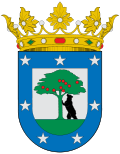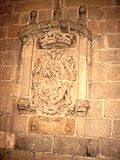
Coat of arms of Madrid
Encyclopedia

Heraldic description

Grandee
Grandee is the word used to render in English the Iberic high aristocratic title Grande , used by the Spanish nobility; Portuguese nobility, and Brazilian nobility....
crown of Or and precious stones, with eight rosettes, five visible, and eight pearls interspersed, (which is commonly used in Spanish heraldry for territorial and municipal Coats) .
History of the Coat


Battle of Las Navas de Tolosa
The Battle of Las Navas de Tolosa, known in Arab history as the Battle of Al-Uqab , took place on 16 July 1212 and was an important turning point in the Reconquista and in the medieval history of Spain...
between Alfonso VIII of Castile
Alfonso VIII of Castile
Alfonso VIII , called the Noble or el de las Navas, was the King of Castile from 1158 to his death and King of Toledo. He is most remembered for his part in the Reconquista and the downfall of the Almohad Caliphate...
and the Almohad
Almohad
The Almohad Dynasty , was a Moroccan Berber-Muslim dynasty founded in the 12th century that established a Berber state in Tinmel in the Atlas Mountains in roughly 1120.The movement was started by Ibn Tumart in the Masmuda tribe, followed by Abd al-Mu'min al-Gumi between 1130 and his...
s, the council of Madrid sent a detachment in support of the Christian king. We know, by chronicles of the time, that these troops carried a flag or banner which identified them: a statant bear on a silver field. This is the first mention in history, of the shield of Madrid.
Soon after, in 1222, a fact took place that modified the shield of the town. The clergymen of the Madrilenian parishes confronted the Council for the use of the fodder
Fodder
Fodder or animal feed is any agricultural foodstuff used specifically to feed domesticated livestock such as cattle, goats, sheep, horses, chickens and pigs. Most animal feed is from plants but some is of animal origin...
in the fields and forests in the municipal jurisdiction. Those were important resources for both institutions, and both wanted the use of these lands. Due to the importance of both groups affected, a royal mediation was necessary. The sentence declared by Alfonso VIII determined that the fodder would belong to the clergymen, whereas the forests would pertain to the Council. This decision did not convince the clergymen, but satisfied the Council. In fact, the council was so satisfied, that it immediately modify the shield of the municipality, adding a tree as proof of its new possessions. The figure of the bear ceased to appear walking, to be over its back legs, eating fruits from the tree.

